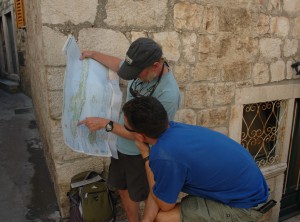Discover Croatia among its idyllic islands

The Romanca, a hand built 100-foot wooden sailing vessel, was our home and transportation as we sailed the Adriatic among islands between Dubrovnik and Spilt along the coast of Croatia.
An Adriatic voyage between Croatia’s Dubrovnik and Split is ideal aboard a small ship that can weave among the islands allowing passengers to disembark and explore. Only 60 of the 1,186 islands are inhabited, mostly by folks living in ancient stone cottages that blend well into the stony backdrop, effectively hiding them from long ago pirates.
I sailed aboard the 115-foot Romanca, a hand built wooden sailing ship with a half dozen air conditioned cabins and a chef serving three meals a day. Everyday he’d put out fresh ripe tomatoes layered with just-made mozzarella drizzled with the most wonderful olive oil. Not a single meal overlooked the provisions from the land and sea, gathered by our chef at dawn markets ashore.
The ship would typically drop us off on one side of an island and pick us up on the other side. Our Croatian speaking guide would lead us among vineyards, along rocky coasts sheltered by tall cypress trees, up steep hillside paths to remote monasteries and to outdoor village harvest markets.
At one of them I discovered a fruit the vendor called oskorusa, resembling an apple but smaller and reddish brown. It was unlike anything I’d ever tasted before. Soon we all began to seek out olive oil.
Everywhere are ancient olive trees and ripening pomegranates, gardens heavy with tomatoes and palm-shaded seaside promenades with cafés inviting a linger over a glass of wine or cappuccino.
The sea here is so clean that it’s easy to see fish and sea urchins living in water that looks to be inches deep but deep enough for our ship to tie up at village docks. We explored Hvar, Orebić, and Vis and stopped at Brač where limestone that built the White House was quarried.
The ancient hilltop hamlet of Škrip on Brač was home two centuries before Christ for the Illyrians, who settled atop hills to defend themselves against Greek invaders. Romans arrived in 167 BC to begin quarrying stone for their mansions.
A Brač stone cutting school still teaches in the same ways taught for 2,000 years. We were given the chance to try it ourselves and quickly understood why the school’s graduates easily find work all over the world. Four to six-week long summer classes are available for interested adults.
The same white stone was harvested by the slaves of fourth-century Roman Emperor Diocletian and transported to Split to build his palace.

Guarding the Diocletion Palace in Split is a wizard-like statue that brings luck when his foot is rubbed.
Today, the Diocletian Palace walls embrace Old Town Split, where 900 families live, and shops line a rabbit warren of narrow streets. It is the best-preserved Roman structure in the world, a tribute to the stone and the craftsmanship used to transform Brač’s stone cutting school’s stone into streets and walls, statues and design elements.
All too soon our voyage was over and we spent our last day in Split, which, it turns out, is a crossroads for travel to the islands by the Jadrolina ferry and voyages such as ours.
Follow the embedded links for a closer look at some of our adventures in Croatia.





Recent Comments